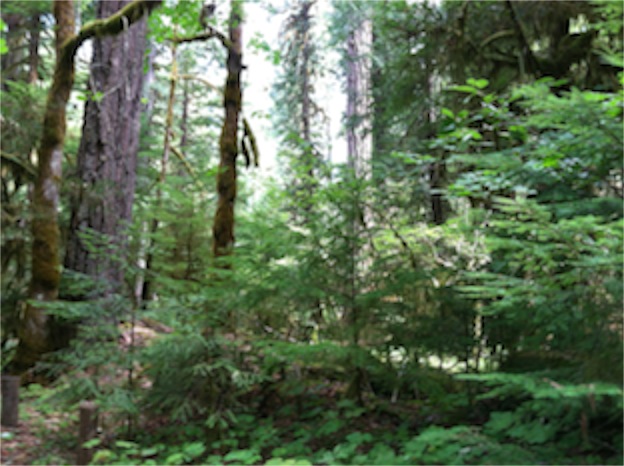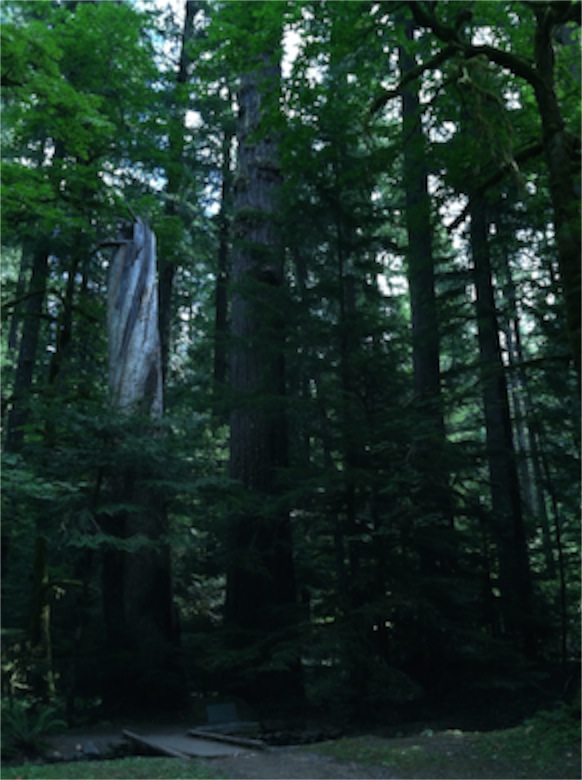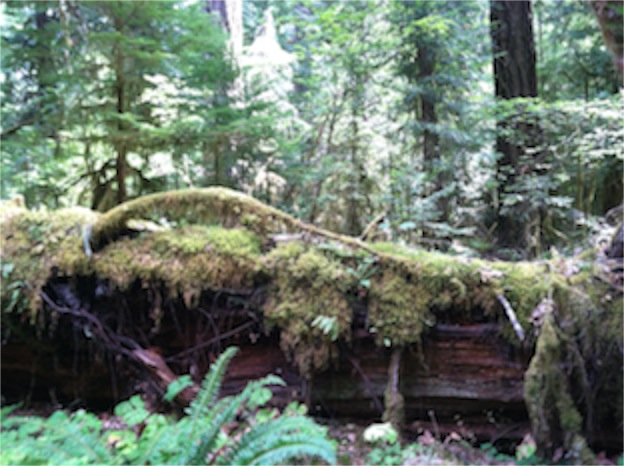Gifford Pinchot National Forest
28/08/12 05:48
I imagine that October 15, 1949 was a beautiful day in the middle Cascades in Washington, though I do not know what the weather was like on that day. I wasn’t even born yet. But I have been in the Cascades in October several times and I know that it can be crisp and cool and beautiful. I know that it can also be rainy and foggy and chilly. But I imagine that the day was one of those crisp and clear mountain days when Mt. Rainer, Mt. St. Helens and Mt. Adams are all clearly visible in all of their glory. There probably would have been more snow on all of the mountains that year. Mt. St. Helens would have hat its top in tact, piercing the clouds like the other mountains, decades away from the dramatic eruption that carved the giant caldera that is now where the peak once was.
 A small group of officials were gathered in a wooded area alongside U.S. Highway 12. Giant trees surrounded them. The Western Red Cedar, Hemlock, Douglas Fir and Spruce trees all topped 100 feet in height. The forest was rich with undergrowth and smelled a little like decaying wood, but the cedar smell covered the dampness and it felt as if giants surrounded the small group gathered. The place still feels that way. The trees are so high and thick that you can’t see the areas where large sections of the mountains have been clear cut and denuded of trees.
A small group of officials were gathered in a wooded area alongside U.S. Highway 12. Giant trees surrounded them. The Western Red Cedar, Hemlock, Douglas Fir and Spruce trees all topped 100 feet in height. The forest was rich with undergrowth and smelled a little like decaying wood, but the cedar smell covered the dampness and it felt as if giants surrounded the small group gathered. The place still feels that way. The trees are so high and thick that you can’t see the areas where large sections of the mountains have been clear cut and denuded of trees.
Among the officials were the head of the U.S. Forest Service and the Secretary of the Interior. They were there to make the official designation of the Gifford Pinchot National Forest and to install a brass plaque officially marking the occasion. The place for the plaque was at the base to two giant trees standing next to each other. One was a Western Red Cedar, the other a Douglas fir. They stood alongside a small creek and towered over the neighboring trees. The cedar has since died and its top been blown off, but the fir is healthy and thriving.
It was just over three years after the death of Gifford Pinchot, who died of leukemia in Pennsylvania at the age of 81. He had lived a long, varied and intensely political life. He had written books, served under presidents, been the first chief of the U.S. Forest Service under Theodore Roosevelt, endured controversy and led a group who split from the Republican Party and formed the Progressive Party. He had served twice as governor of Pennsylvania. And he had loved the forests of this land like no one else.
 Naming a forest after him was a fitting tribute to the man. The Cascades are home to the Pacific Temperate Rainforest, a dramatic ecosystem that produces dramatic and long-lived trees.
Naming a forest after him was a fitting tribute to the man. The Cascades are home to the Pacific Temperate Rainforest, a dramatic ecosystem that produces dramatic and long-lived trees.
Back in those days, they didn’t know much about forest management. Actually they knew a lot, but we know even more these days. The forests were so large and vast that they seemed limitless and as if they could never be depleted. Fire was seen as an enemy of the forest and fought with all of the resources they could muster. The role of fire in a healthy forest ecosystem wasn’t understood. Bill Greeley, who became head of the forest service in 1920 was convinced by the firestorm of 1910 that fire was the work of Satan and that fighting fire should be the primary mission of the Forest Service. It wasn’t the only issue upon which he was proven wrong by history. It wasn’t the only thing with which he found disagreement and opposition from Gifford Pinchot.
Fresh back from the success of World War II the Army Corps of Engineers was convinced that they could build anything, given enough resources. Together with the Bonneville Power Administration, they set out to build as many dams and power plants as possible throughout the cascades, producing electricity to power the aluminum foundries and the Boeing aircraft factory in Seattle. Pinchot had proposed the concept of multiple use of the forests, but he lived long enough to regret some of the things that were being done to the forests.
He was most vocal in his opposition to clear cutting of the forests. Pinchot and Theodore Roosevelt had envisioned that public timber should be sold only to small, family-run logging outfits, not to big syndicates. Pinchot had always preached of a “working forest” for working people and small scale logging at the edge, preservation at the core. Bill Greely had a different vision. After his stint at the head of the forest service, he was an executive of the West Coast Lumberman’s Association. When Pinchot witnessed the legacy of Bill Greely, it “tore his heart out.” Industrial clear cuts became the norm in the national forests of Montana and Oregon. Entire mountainsides, mountain after mountain, were denuded of all trees. Pinchot wrote in his diary: “So this is what saving the trees was all about. Absolute devastation. The Forest Service should absolutely declare against clear cutting in Washington and Oregon as a defensive measure.”
 The politics of the Forest Service have turned off some naturalists, but Pinchot was ready for the rough and tumble of the political life. He believed in the power of government to do good. He believed that there were things that we could do together that required a strong government. He ran for the U.S. Senate, served as a governor, and even spoke of a run for the presidency. He saw the political process as a way to provide for the good of the people. He fought plenty of battles, won a few and lost others.
The politics of the Forest Service have turned off some naturalists, but Pinchot was ready for the rough and tumble of the political life. He believed in the power of government to do good. He believed that there were things that we could do together that required a strong government. He ran for the U.S. Senate, served as a governor, and even spoke of a run for the presidency. He saw the political process as a way to provide for the good of the people. He fought plenty of battles, won a few and lost others.
He was an icon in his family. Every generation since his time has named one of its sons Gifford, right down to Gifford Pinchot IV. But he will also be remembered as the partner of president Theodore Roosevelt in the establishment of the National Forest System. It is fitting that one of those forests be named for him and that it include a huge grove of old growth trees that tower above the heads of visitors. There is no highway marker telling of the plaque. You have to chance upon it or be looking for it on purpose. The trees, however, are impossible to ignore.
For those who are following my blog as a travelogue, we bid farewell to our son and his family yesterday and are on our way home. We’re camped on the banks of the Clearwater River near Orofino, Idaho. One more night on the road and we’ll be home.

Among the officials were the head of the U.S. Forest Service and the Secretary of the Interior. They were there to make the official designation of the Gifford Pinchot National Forest and to install a brass plaque officially marking the occasion. The place for the plaque was at the base to two giant trees standing next to each other. One was a Western Red Cedar, the other a Douglas fir. They stood alongside a small creek and towered over the neighboring trees. The cedar has since died and its top been blown off, but the fir is healthy and thriving.
It was just over three years after the death of Gifford Pinchot, who died of leukemia in Pennsylvania at the age of 81. He had lived a long, varied and intensely political life. He had written books, served under presidents, been the first chief of the U.S. Forest Service under Theodore Roosevelt, endured controversy and led a group who split from the Republican Party and formed the Progressive Party. He had served twice as governor of Pennsylvania. And he had loved the forests of this land like no one else.

Back in those days, they didn’t know much about forest management. Actually they knew a lot, but we know even more these days. The forests were so large and vast that they seemed limitless and as if they could never be depleted. Fire was seen as an enemy of the forest and fought with all of the resources they could muster. The role of fire in a healthy forest ecosystem wasn’t understood. Bill Greeley, who became head of the forest service in 1920 was convinced by the firestorm of 1910 that fire was the work of Satan and that fighting fire should be the primary mission of the Forest Service. It wasn’t the only issue upon which he was proven wrong by history. It wasn’t the only thing with which he found disagreement and opposition from Gifford Pinchot.
Fresh back from the success of World War II the Army Corps of Engineers was convinced that they could build anything, given enough resources. Together with the Bonneville Power Administration, they set out to build as many dams and power plants as possible throughout the cascades, producing electricity to power the aluminum foundries and the Boeing aircraft factory in Seattle. Pinchot had proposed the concept of multiple use of the forests, but he lived long enough to regret some of the things that were being done to the forests.
He was most vocal in his opposition to clear cutting of the forests. Pinchot and Theodore Roosevelt had envisioned that public timber should be sold only to small, family-run logging outfits, not to big syndicates. Pinchot had always preached of a “working forest” for working people and small scale logging at the edge, preservation at the core. Bill Greely had a different vision. After his stint at the head of the forest service, he was an executive of the West Coast Lumberman’s Association. When Pinchot witnessed the legacy of Bill Greely, it “tore his heart out.” Industrial clear cuts became the norm in the national forests of Montana and Oregon. Entire mountainsides, mountain after mountain, were denuded of all trees. Pinchot wrote in his diary: “So this is what saving the trees was all about. Absolute devastation. The Forest Service should absolutely declare against clear cutting in Washington and Oregon as a defensive measure.”

He was an icon in his family. Every generation since his time has named one of its sons Gifford, right down to Gifford Pinchot IV. But he will also be remembered as the partner of president Theodore Roosevelt in the establishment of the National Forest System. It is fitting that one of those forests be named for him and that it include a huge grove of old growth trees that tower above the heads of visitors. There is no highway marker telling of the plaque. You have to chance upon it or be looking for it on purpose. The trees, however, are impossible to ignore.
For those who are following my blog as a travelogue, we bid farewell to our son and his family yesterday and are on our way home. We’re camped on the banks of the Clearwater River near Orofino, Idaho. One more night on the road and we’ll be home.